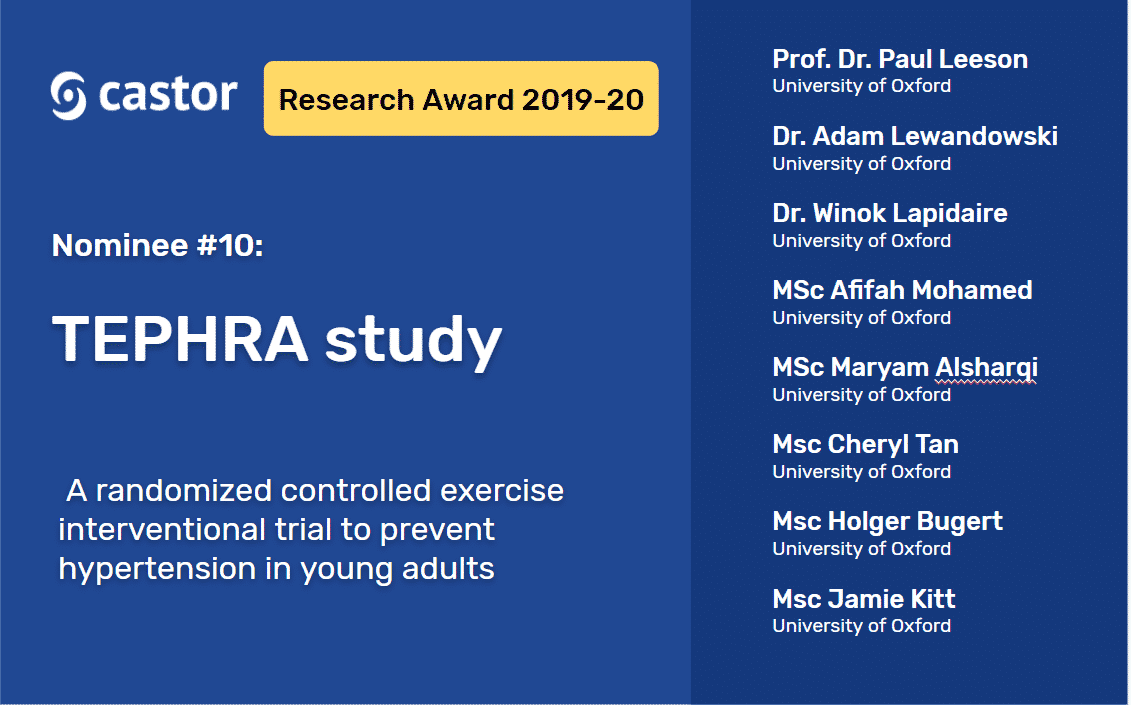High blood pressure affects at least 1 in 4 adults and is becoming more common in young adults. Over time high blood pressure increases a person’s risk for complications such as stroke. Castor Research Award Nominee #10 uses the TEPHRA study to ask how exercise acts to reduce blood pressure in young adults, along with how being born prematurely may affect the chance of developing high blood pressure.
Research Overview
The team is conducting a randomized, controlled exercise intervention trial to (1) learn more about hypertension in young adults and to (2) better understand how exercise acts to reduce blood pressure and (3) how being born prematurely may affect this relationship.
High blood pressure affects at least 1 in 4 adults and is increasingly common in the young adult population. Previous studies indicate that being born preterm may modify the cardiovascular system and increase a person’s chance of developing high blood pressure. Over time, high blood pressure increases a person’s risk for complications such as stroke. Most studies investigate populations in mid to late life, when cardiovascular disease is often already manifested. In particular, the effect of exercise on the blood pressure and cardiovascular system of preterm born young adults has not been well studied or reported.
The team is investigating if it is possible to prevent the development of cardiovascular disease earlier in life and change people’s trajectory.
About the team
Team members at the University of Oxford, Oxford Cardiovascular Clinical Research Facility (CCRF) come from a wide variety of academic and cultural backgrounds:
- Dr. Paul Leeson leads the CCRF and is a professor of cardiovascular medicine and a consultant cardiologist.
- Dr. Adam Lewandowski is a university research lecturer and CCRF’s deputy director.
- Winok Lapidaire (CRA submission author): Postdoctoral researcher specializing in brain MRI analysis.
- The team has a number of doctorate students, each focusing on a different aspect of our TEPHRA study
- Afifah Mohamed focuses on cardiac MRI
- Maryam Alsharqi comes with expertise on echocardiography
- Cheryl Tan analyzes blood samples
- Holger Bugert is most interested in cardiopulmonary fitness
- Jamie Kitt, a clinical research fellow and cardiology specialty registrar who, despite running his own pre-eclampsia management trial, still finds time to help out with the TEPHRA study.
During the trial, some members of the team have completed their doctorates and graduated; Wilby Williamson, an academic clinical fellow in exercise physiology, and Odaro Huckstep, who also serves as a lecturer in the US army in exercise and cardiovascular physiology. The research assistants are doing invaluable work on the study visits and data management, and also each brings in their unique skillset. Annabelle McCourt completed a master’s degree in exercise physiology after a career at the HM Forces (UK army), while Will Woodward and Cameron Dockerill completed degrees in medical physiology. The administrative staff has been critical during the planning and recruitment stages; Yvonne Kenworthy, a research midwife, Polly Whitworth, a senior research nurse, and data coordinators Aggy Plachecka and Jo Sawyer. The exercise intervention is run at Brookes University under the leadership of Professor Helen Dawes.
Study design and methodology
TEPHRA study has 203 participants from 18-35 years old, with slight to moderate blood pressure elevation. Fifty-two participants have been born preterm (<37 weeks of gestation). Half the participants from each birth group were randomly placed into a 16-week supervised aerobic exercise program and the other half maintained their normal daily routines.
Study participants attend three similar study visits over the course of a year. At each study visit, the team collects a range of non-invasive measurements including ultrasound imaging of the heart (echocardiography), accurate blood pressure measurements, peak exercise testing on a stationary bike, and collecting images of the small blood vessels in the skin and back of the eye. Half of the TEPHRA participants will also complete magnetic resonance imaging of the heart, brain, and liver. Study visits last about three hours.
Research outcome
The primary outcome is a blood pressure change in response to exercise (i.e., the exercise group compared to the control group). However, we have outcome measures related to the structure and function of the heart, brain, liver, blood vessels as well as compound levels in the blood, demographic variables, birth history, family history of illness, and anthropomorphic measures. We have all of these measures for Visit 1 and Visit 2, and some also for a follow-up visit after 52 weeks.
How TEPHRA study team uses Castor
We switched to Castor data collection halfway through the TEPHRA study because it provides a much better interface to integrate data from different sources and different time points. Since we have so many different modalities for data acquisition (MRI, Echo, blood sample, retinal imaging, etc.), we have allocated every member of the team with the responsibility for at least one of these sub-datasets. Each team member set up the step with corresponding variables to the study structure. Depending on the way the data is collected and the amount of data processing and cleaning that is required, the data is entered from paper files or uploaded from a .csv file.
When we switched to Castor, recruitment pipelines were already in place, and therefore we have mainly used Castor as a retrospective database for this study. However, we now have new studies starting with Castor that use tablets to input data directly during the study visits and make use of the survey, recruitment, and randomization features. Our department has since purchased a license and after having heard our positive experience with Castor, the medical imaging analysis company Perspectum has also acquired a substantial number of commercial licenses.
“We very much enjoy the fact that we can easily enter the same data points for multiple study visits,” said Dr. Winok Lapidaire. “Additionally, it has proven extremely useful that we can upload data from .csv files as well as directly input data via the user interface. For future studies, I think that the survey function could be very useful since this could save us a lot of manual entering data from paper records and keep better track of which participants have completed questionnaires at home.”
Stay tuned on the Castor EDC blog for more 2019-2020 Castor Research Awards nominations. We wish the nominees good luck and smart science—and encourage all researchers to share their projects for the chance to win €3000!

